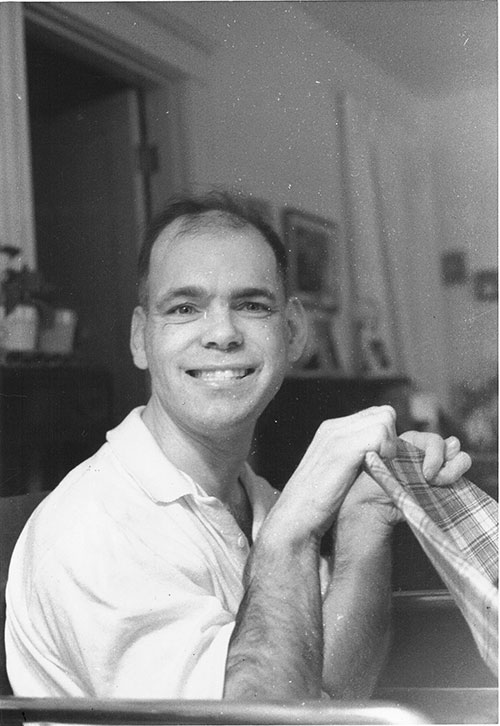Larry Eigner, Six Letters: An Introduction
BY George Hart
Larry Eigner (1927–1996) wrote over three thousand poems on a manual Royal typewriter (a bar mitzvah gift) with the thumb and index finger of his right hand. Disabled by a forceps injury at birth, Eigner lived with cerebral palsy his whole life; able to walk only with support or assistance, he made his way through the world in a wheelchair. Until his father died and his mother was too old to care for him, he lived at home in Swampscott, Massachusetts, writing many of his poems in the glassed-in front porch that served as his office. In 1978, Eigner relocated to Berkeley, California, at first living in a communal house for adults with disabilities and then residing with poet-friends, mainly Robert Grenier and Kathleen Frumkin, who also served as his caregivers.
In late 1949, Eigner heard Cid Corman reading Yeats on his Boston radio program This Is Poetry. Eigner didn’t like the manner in which Corman read Yeats’s poetry aloud and wrote a letter to tell him so. A long friendship and correspondence between the two poets followed. Through Corman, Eigner was introduced to Robert Creeley, whose Divers Press published his chapbook From the Sustaining Air in 1953. Creeley and Corman were both associated with Charles Olson and the Black Mountain school of poetry, and through them Eigner began reading Olson’s Maximus Poems and the work of modernist poets such as William Carlos Williams and Ezra Pound.

Larry Eigner circa 1950
Throughout the fifties, Eigner absorbed Olson’s theory of Projective Verse, and he was grouped with the Black Mountain poets in Donald Allen’s groundbreaking The New American Poetry anthology in 1960. Of the poets in this group — Olson, Creeley, Robert Duncan, and Denise Levertov (Corman chose not to be included in the anthology) — Eigner might be the one who put Olson’s theories to work most productively. Projective Verse, with its emphasis on the exchange of energy between poet and reader, and the typewriter as a means of graphing or scoring words on the space of the page, seems particularly well-suited to Eigner’s embodiment and temperament. The fact that Olson put so much stress on the stance of the poet and the poet’s breath as a form of measure, which might seem to discourage someone like Eigner who had difficulty walking and speaking, makes Eigner’s achievement even more impressive. In excerpting Eigner’s correspondence for this special feature, Jennifer Bartlett and I have chosen to focus on passages in which he writes about, or directly to, Olson regarding his poetry, poetics, and other Black Mountain poets.
In his review of The New American Poetry, published in the July 1961 issue of Poetry, X.J. Kennedy chided Olson for his proposal that the typewriter can replace meter as a means of graphically scoring the poet’s breath, writing, “Who would have thought his Corona portable an instrument of such sensitivity?” In 1962, the September issue of Poetry included six poems by Eigner and a review of his first full-length collection, On My Eyes, by Galway Kinnell, who also found fault with Projective Verse’s claims for the typewriter. He writes,
The real value of getting rid of rhyme and meter, I had supposed, was in order to throw the responsibility for the poem wholly on speech itself. Here this is not done. The laying out of a kind of score by typewriter-spacing only supplants those old devices with a newer one, which is, this time, not even integral with the words.
The four-volume Collected Poems of Larry Eigner, edited by Curtis Faville and Robert Grenier (Stanford University Press, 2010), provides enough examples for readers to judge for themselves whether or not Eigner succeeded in using the typewriter as Olson had proposed, but there is no doubt that a 1940 Royal typewriter is integral to his words. Without that bar mitzvah present, wisely chosen by his mother Bessie and purchased by an aunt, we may never have heard his voice.
Because it was difficult for him to insert a piece of paper into the carriage of his typewriter, Eigner tended to use as much of the page as possible before starting another (a habit also motivated by his obsession with saving paper). He would commonly type multiple poems on a single sheet, and when writing in prose he would type as close to the margin as possible, or fill up the margins with additional notes and comments after writing the main text. We have indicated relevant marginal comments made by Eigner in brackets. Eigner also used abbreviations to save time while typing. Some are standard abbreviations such as yrs for years or bk for book, but some are produced by Eigner omitting letters in his own elliptical way — wndr for “wonder,” for example, or grp for “group.” We have retained these when the context clarifies what word is meant, or added a bracketed word if needed. Eigner occasionally mistrikes the keys on his typewriter — we have silently corrected any such obvious mistakes but have left misspellings and other typos. Two other idiosyncratic uses of the typewriter should be mentioned: Eigner often indicated poem titles by inserting a space between each character and he indicated notes or asides by overstriking an open and close parenthesis to form his own piece of punctuation. These have been retained. Material omitted from the letters by the editors is indicated by bracketed ellipses.
— George Hart


